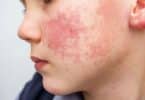 The U.S. Centers for Disease Control and Prevention reported today that about 3 million U.S. children have a food or digestive allergy – an 18 percent increase over the past 10 years.
The U.S. Centers for Disease Control and Prevention reported today that about 3 million U.S. children have a food or digestive allergy – an 18 percent increase over the past 10 years.
The CDC’s National Center for Health Statistics found eight types of food account for 90 percent of these food allergies: milk, eggs, peanuts, tree nuts, fish, shellfish, soy and wheat.
Reactions range from a tingling sensation around the mouth and lips, to hives and sometimes even death in the most severe cases.
Children with a food allergy are two to four times more likely than other children to have asthma and other allergies, as well.
In 2007 the report found that:
- 29 percent of children with a food allergy also had asthma, compared to 12 percent of children without food allergies.
- About 27 percent of children with a food allergy had eczema or other skin allergies, compared to 8 percent of most children
- 30 percent had respiratory allergies, compared with 9 percent of the general population under the age of 18.
Overall, 3.8 percent of boys and 4.1 percent of girls had food allergies, the NCHS found. No one knows how or why children develop food allergies.
Most children outgrow the allergy, although some remain allergic for life.






